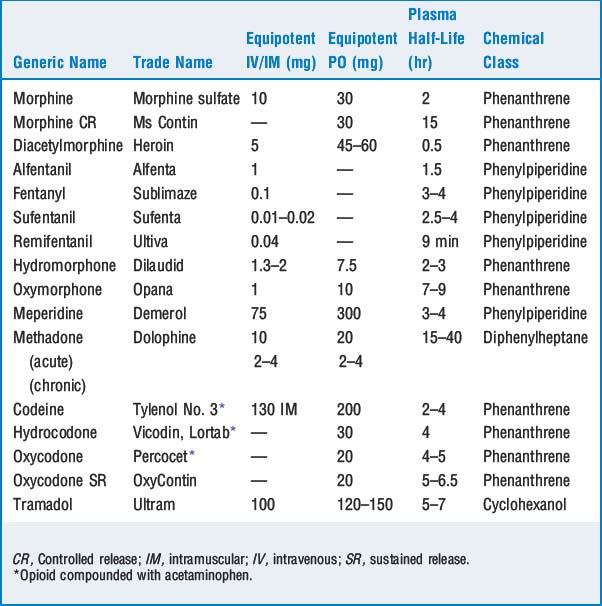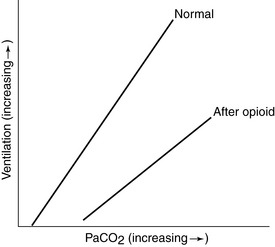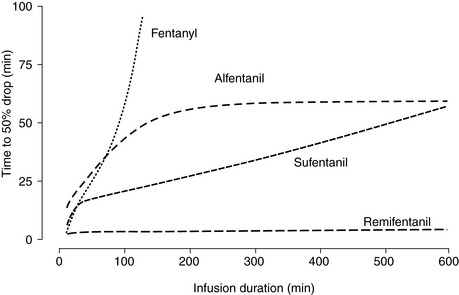CHAPTER 11 Opioids
1 What is an opiate? An opioid? A narcotic?
 Opiates are analgesic and sedative drugs that contain opium or an opium derivative from the poppy plant (Papaver somniferum). Opiates include opium, morphine, and codeine.
Opiates are analgesic and sedative drugs that contain opium or an opium derivative from the poppy plant (Papaver somniferum). Opiates include opium, morphine, and codeine.(no longer classified as opioid receptor)
Modified from Stoelting RK, Miller RD: Basics of Anesthesia, ed 4, New York, 2000, Churchill Livingstone, p 71.
13 Describe the cardiovascular effects of opioids
KEY POINTS: Opioids 
14 Describe the typical respiratory pattern and ventilatory response to carbon dioxide in the presence of opioids
Opioids reduce alveolar ventilation in a dose-dependent manner. They slow the respiratory rate and may cause periodic breathing or apnea. Graphically opioids shift the alveolar ventilatory response–to–carbon dioxide curve down and to the right. Accordingly, for a given arterial carbon dioxide level the alveolar ventilation will be reduced in the presence of opioids. Furthermore, an increase in arterial carbon dioxide will not stimulate an appropriate increase in ventilation. Opioids also impair the hypoxic ventilatory drive (Figure 11-1).
15 Describe the analgesic onset, peak effect, and duration of intravenous fentanyl, morphine, and hydromorphone
16 Explain how fentanyl can have a shorter duration of action but a longer elimination half-life than morphine
17 Explain the concept of context-sensitive half-time and its relevance to opioids
Context-sensitive half-time is the time required for a 50% reduction in the plasma concentration of a drug on termination of a constant infusion. This time is determined by both elimination and redistribution, and it varies considerably as a function of infusion duration for commonly used opioids (Figure 11-2).
1. Coda B.A. Opioids. In Barash P.G., Cullen B.F., Stoelting R.K., editors: Clinical anesthesia, ed 5, Philadelphia: Lippincott Williams & Wilkins, 2006.
2. Crawford M.W., Hickey C., Zaarour C., et al. Development of acute opioid tolerance during infusion of remifentanil for pediatric scoliosis surgery. Anesth Analg. 2006;102:1662-1667.
3. Fukuda K. Intravenous opioid anesthetics. In Miller R.D., editor: Anesthesia, ed 6, Philadelphia: Elsevier, 2005.
4. Gillman P.K. Monoamine oxidase inhibitors, opioid analgesics and serotonin toxicity. Br J Anaesth. 2005;95:434-441.
5. Kirchheiner J., Schmidt H., Tzvetkov M., et al. Pharmacokinetics of codeine and its metabolite morphine in ultra-rapid metabolizers due to CYP2D6 duplication. Pharmacogenomics J. 2007;7:257-265.
6. Krantz M.J., Martin J., Stimmel B., et al. QTc interval screening in methadone treatment: the CSAT consensus guideline. Ann Intern Med. 2009;150:387-395.
7. Moss J., Rosow C.E. Development of peripheral opioid antagonists: new insights into opioid effects. Mayo Clin Proc. 2008;83:1116-1130.
8. Smith H.S. Peripherally-acting opioids. Pain Physician. 2008;11:S121-S132.
9. Viscusi E.R., Martin G., Hartrick C.T., et al. Forty-eight hours of postoperative pain relief after total hip arthroplasty with a novel, extended-release epidural morphine formulation. Anesthesiology. 2005;102:1014-1022.







